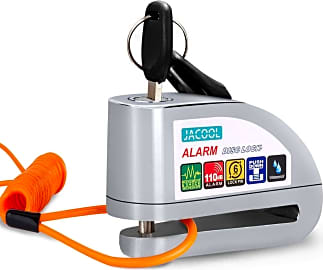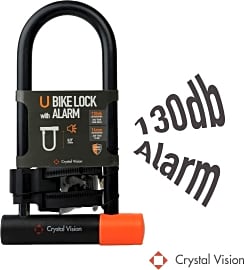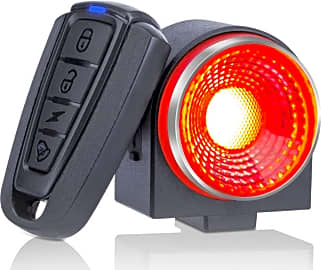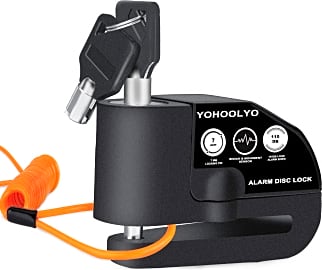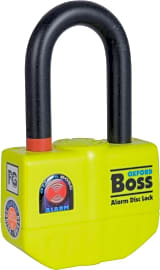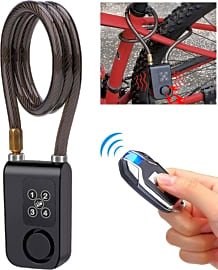The 10 Best Bike Alarms

This wiki has been updated 30 times since it was first published in January of 2018. Whether you use it to commute to work, for exercise, or for fun, a bike is an investment you'll want to protect. While a lock is a great first step in keeping your ride secure, an alarm will deter potential thieves and draw attention if anyone makes an attempt to steal it. Many of the models in our selection offer some sort of locking mechanism as well, while others double up as a taillight. When users buy our independently chosen editorial selections, we may earn commissions to help fund the Wiki.
Editor's Notes
December 02, 2020:
The items in this list fall roughly into three categories: alarms that light, alarms that lock, and alarms that sound only. Some people will need both an alarm and a lock in one, while others may want to keep these idea separate, concealing the alarm under a saddle or disguising it as part of a lamp.
If you already have a way to secure you wheels, the WSD Cam Wireless is an inexpensive alarm that can be operated remotely with plenty of sensitivity modes to stop it being triggered too easily. Alternatively, you could combine your alarm with a taillight by purchasing either the Onvian 2-In-1, or the G Keni A6, both of which come with a remote control and feature multiple light modes.
If your bike has a brake disc, then you can prevent it from being wheeled away by attaching either the Jacool Disc Brake Lock, or the Yohoolyo LK603, both of which come with reminder cables to stop you absentmindedly trying to pedal away with them still attached.
Most people will probably want to combine their alarms with a lock if they can, keeping their security solutions simple. If you like U-locks, then the Oxford OF3 Boss will take some beating for indestructibility, although it doesn't come with any means for mounting it to your bike, unlike the Crystal Vision U-Lock that hangs neatly under your toptube as you ride.
If you prefer cable locks, then the Wsdcam Cable Lock or the Nunet Nulock are your best bet. The former has a remote control while the latter uses Bluetooth to connect to your smartphone app.
Finally, we added the Abus Bordo Plus as a solid (but rather pricey), folding lock option that won't go off while you're traveling with it mounted to your seat tube, and folds out to create quite a large locking area.
April 30, 2019:
When evaluating the best bike alarms we included models that double as a bike lock and choices that only function as an alarm because those tend to have other useful features like the G Keni A6 that also adds a rear taillight that can flash.
While the Bluetooth-enable Nunet Nulock contains some of the most advanced technology of the bunch, we didn't rank it first because simplicity is sometimes better, especially if you're the kind of person who doesn't keep your phone fully charged at all times.
The WSD Cam Wireless does not double as a lock, but it's still ranked first for being the only choice to offer adjustable sensitivity levels for users who are worried about disturbing neighbors for false alarms, and it's unobtrusive design.
A Brief History of Vehicle Alarms
Then again, you'd think blowing up bicycle thieves would put a stop to the problem sooner or later...
For as long as man has had something to ride, there's been another man out there trying to steal it.
The original rides were animals, and the only real alarm available was a trustworthy dog. When cars were invented, though, they quickly became targets for thieves. The first known incident of a car being stolen dates all the way back to 1896 C.E., when Baron de Zuylen had his Peugeot taken off his hands by his mechanic. This was pretty brazen, as it was probably hard to deny that you stole the vehicle when there were only a handful of cars in the entire world.
The first vehicle alarm came along in 1913, and it was created by a criminal (how convenient). You had to set it by hand, and it went off whenever some rapscallion tried to crank the engine.
Meanwhile, there were other valuable vehicles that were even more likely to be stolen: bicycles. Instead of alarms, though, manufacturers focused on locks which would go around the spokes, locking them in place.
Car alarms became standard issue in some cars in the 1970s. These early models were easily defeated — in some cases, all you had to do was yank out a wire under the bumper.
Car alarms have since grown more sophisticated, and bike alarms have followed suit. There are now bicycle alarms that you can program with your smartphone, and even one that explodes if an evildoer rides off on it (the exploding device was created by yet another thief, Mr. Wile E. Coyote of the Acme Corporation).
Despite that, there's some dispute as to how effective these devices truly are, as a dedicated criminal can probably find a way around any system you install.
That doesn't mean you shouldn't use them, however. It just means that they're best utilized in conjunction with other strategies.
Then again, you'd think blowing up bicycle thieves would put a stop to the problem sooner or later...
Choosing the Right Bike Alarm
When trying to decide on a bike alarm, there are a few variables to keep in mind during your research process.
The first is how you want it to defend your bike. Some try to physically restrain your bike in addition to warning you if someone tries to ride off on it, while others simply try to scare off would-be thieves with loud noises.
Some options even allow you to operate them remotely, using either a key fob or your smartphone.
The former offers a second layer of protection, as the thief will have to saw or cut through the chain while the alarm is going off — and the last thing a criminal wants is more attention. The latter type, on the other hand, won't give you as much security up-front, but they're usually easier to hide on the bike. The downside to this is that you lose any deterrent value that the alarm would have.
Consider how easy the thing will be to operate as well. If it's a huge hassle, you're less likely to use it, which means you wasted money on the alarm and you're more likely to lose your bike. Some options even allow you to operate them remotely, using either a key fob or your smartphone.
Finally, think about how sensitive you want it to be. If it's not sensitive enough, it might not go off when you need it, but if it's too responsive, you'll be dealing with lots of false alarms. Some models let you configure the sensitivity to your liking.
At the end of the day, the only way to be completely sure your alarm works is to walk outside and find your bike still sitting where you left it. Then again, if your bike is still there, did you even need the alarm in the first place? (Answer: yes.)
Keeping Your Bike Safe
If you want to keep your expensive bike for longer than a few days, then buying an alarm is a good start. However, there are other actions you can take to deter thieves even further. (And you should take action, as bike thefts are on the rise, and over half of all active cyclists will have their ride stolen at some point.)
There are two reasons why your bike will get stolen: joyriding or financial gain. Joyriders are unlikely to put much effort into the theft, and are easy to deter. The committed criminals require a little more work.
If they like to ride off with it, though, simply having a siren attached should do the trick.
Some like to just grab the bike and throw it in a truck or van, in which case you'll need a chain to connect it to something. If they like to ride off with it, though, simply having a siren attached should do the trick. Contact your local law enforcement office and see if they have any information about how bike thieves operate in your area.
Watch out for sucker poles as well. These are poles that look like a secure place to lock your bike, but that can be taken apart quickly by thieves. Inspect anything you're thinking about attaching your bike to before you lock it.
Always try to park it somewhere near a crowd. Also, if you come back to the bike rack to find out that your tire has been punctured, take the bike home with you. Many criminals assume you'll leave it there until you come back with a new tire or a repair kit, which may take a few days — and by the time you come back, it'll be gone.
Your chains and locks should be as thick as possible, too. Hopefully that'll make stealing it such a chore that any passerby with sticky fingers will keep looking.
Beyond that, the best way to deal with bicycle theft is to simply ride a cheaper bike. The less-expensive ones don't offer much in the way of profit margin, and if yours does get nabbed, you're not out much.
The next-best way is to stash a hive of angry bees under the seat. It's painful, but effective. Also, free honey!



